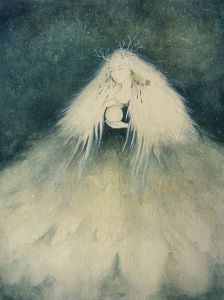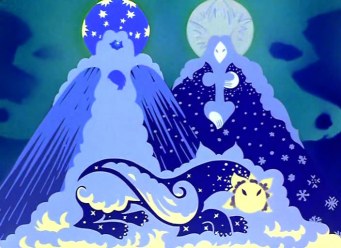Lady of the Moon
Possible Symbols: Moon, night, ocean tides, calendar, menstrual blood, agriculture
Colors: Blue, black, silver, gray, red (in relation to menstrual cycles)
The only information that I have of this being in an Old Magyar context is the name. Hold means moon, Anya means lady. Even then, it’s questionable whether this is just a name (like how contemporary English speakers say “Man in the Moon” while just considering the moon a rock in space), or if this was an actual deity with a personality and a story.
Contemporary Hungarian culture has more beliefs and ideas fleshing out the moon, but the modern agrarian society is rather different than the primarily steppe riding society of 1000 years ago (and who knows what the Hungarians were before that, the scholars who devoted their entire career to this still haven’t figured it out since there’s several theories at the moment). Therefore the values and social needs are different, and we see that many folk beliefs center on the moon cycle being a calender that was most often used to time crop and herding practices. Interestingly enough, “hold” also referred to an area of land (whether it was a unit of land measurement, or was a parcel of land, I cannot tell). There’s also folk beliefs that recognize the cyclical nature of the moon being similar to menstrual cycles, like many other societies have.
Folktales that describe the world tree upon which the taltos climb show the sun and moon being cosmological entities residing in the upper branches of the tree, with no personalities or sense of being attributed to them. There are several depictions of the Sun riding around (i.e. Napkirály in a chariot or on a horse), or being driven around (i.e. a Hungarian Christmas ballad with the Sun being in Csodaszarvas’s antlers) in folktales, but none for the moon that I’ve found thus far.
There’s several possibilities that we can take away from this. For one, maybe the moon just wasn’t an important entity in the deep past, but became important more once the Hungarians became an agrarian society (Other agrarian societies have also used the moon cycles as a calendar for crop activities; in Hungary it is the new moon that marks a new month, in some Germanic cultures it is similar with the first visible waxing crescent marking the new month). The other is that I simply haven’t found the information yet, or that the information is lost to time. Either way, considering Hold Anya as a distinct deity rather than a force of nature is, as far as I can currently tell, not historically attested and is therefore UPG.
My personal view is that Hold Anya could be a deity, but an impersonal one. To be honest the only “deity” attribute I regard her with is to list her as a moon deity (in terms of gendering the moon, while I feel that it’s mostly unnecessary I also feel that the moon shifts between male and female, story-wise). Otherwise my perspective is more along the line of modern Hungarian folk culture. I refer to the literal moon that is seen in the sky, and consider it a force of nature that creates a useful calender and affects the earth’s waters. The Germanic perspective that I also include in my “religion” is similar, where Manu (in this case, a male name) is impersonal and doesn’t have a whole lot to him other than existing and being listed as a deity. I usually just call the moon “Moon” and don’t engage in devotional rituals or create dedicated holy days. The Moon is just there, always watching and always with us.
Images that remind me of them:

When the moon kisses the ocean by beautymothernature.tumblr.com

by holidaylettings.com

by Pui-Mun Law at shadowscapes.com

Tsukiyomi in Moonlight by Edji
~~~
Artwork: Selene by kaelycea.deviantart.com
Sources
Hold by Akadémiai Kiadó (1982). Magyar néprajzi lexikon. http://mek.oszk.hu/02100/02115/html/2-1344.html (paste link into google translate)
Moon Goddess (*KUNKE > KUL >HOD/HOLD) by Fred Hamori (2002). Sumerian and Finn-Ugor god names compared to Sumerian. http://users.cwnet.com/millenia/FUgods.htm




















